Speech Current Economic Developments in Australia – A Broad Perspective
I welcome this opportunity to mention some developments in Australia of likely interest to Japanese institutional investors. At the end of the day, you will reach your own judgments about whether or not to invest in Australia; it is in all our interests, however, that those judgments be based on current data, not outdated perceptions.
Australia traditionally calls upon overseas capital to augment its domestic savings and help finance its investment spending. Using the current account deficit as a rough measure of the national savings gap, we presently require net capital inflow of about $US1 billion ($A1½ billion) a month. The terms we have to pay for that capital – that is, the interest rates and exchange rates which apply – depend ultimately on our attractiveness to overseas investors.
Japan, of course, runs large current account surpluses and every month has some $US10 billion to invest overseas. Only a relatively small part of that investment comes to Australia but it represents about 20 per cent of all foreign investment in Australia.
Until recently, government bond holdings have accounted for a large proportion of Japanese investment in Australia. This serves to highlight the particular importance of interest rates and exchange rates to Japanese investors. Curiously, unlike their American and British counterparts, Japanese investors have shown relatively little interest in equity investment in Australia, especially portfolio equity investment.
The lack of interest in equity is perhaps attributable to earlier unfavourable perceptions of Australia's economic performance. If so, those perceptions are in need of updating. As Graph 1 shows, share prices in Australia have risen strongly over the past year; this mainly reflects lower long-term interest rates, and good profit results and prospects.
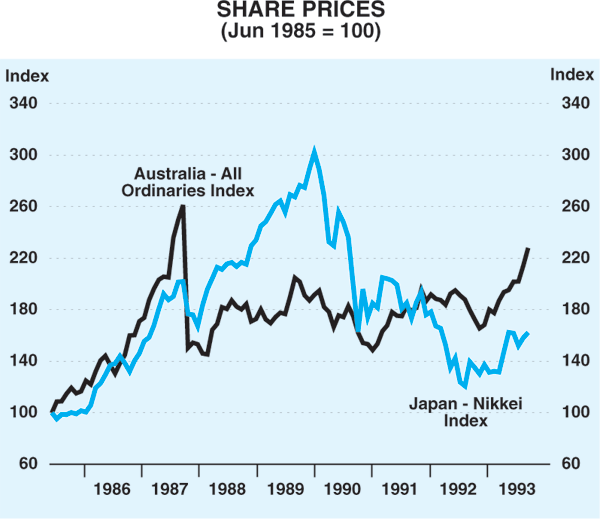
As for government bonds, Japanese investors have done nicely from their investments in Australia over the years. This can be seen from Graph 2, which compares the cumulative returns, in yen, from investments in government bonds in several countries since 1985. Over this period, high coupons and large $A capital gains from falling yields have more than outweighed what, at times, have been unfavourable currency movements.
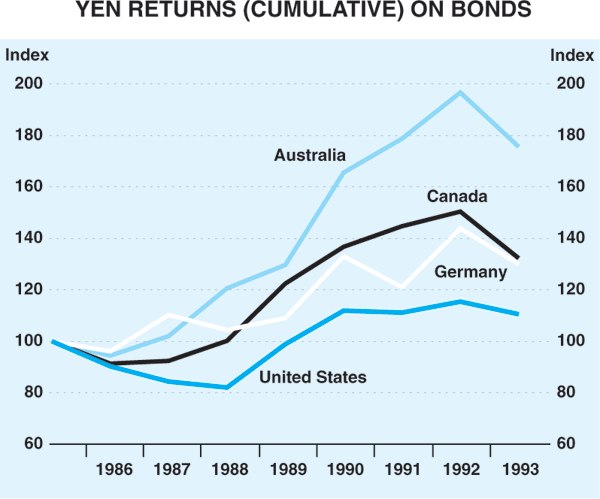
The exchange rate of the $A to the yen was fairly steady in a range of 90–110 over the six years to mid-1992. Since then, the $A has depreciated by 28 per cent against the yen; this is a large fall but it is not out of line with the falls in some other currencies against the yen over this period.
| % | |
| $US | 17 |
|---|---|
| DM | 21 |
| Canadian $ | 24 |
| $A | 28 |
| £Stg | 33 |
Ultimately, what determines the attractiveness of Australia for Japanese (and other) investors is the return on investments, whatever form those investments take. Many factors enter this equation but interest rates and exchange rates are always prominent, both in themselves and as proxies for broader economic and political trends.
Central bankers are not in the business of proffering forecasts of interest rates or exchange rates. I want instead to review recent movements in these rates, as a focus for discussing economic developments and policies which can have implications for future rate movements. My bottom line is that the economic structure of Australia is changing in ways which should be viewed positively by overseas investors.
Interest Rates
Monetary policy in Australia was tightened in 1988 and 1989, before being eased progressively. As shown in Graph 3, the tightening and the easing both occurred somewhat earlier than in Japan (and most other countries). Since January 1990, overnight interest rates in Australia have fallen from 18 per cent to 4¾ per cent. Over the same period, yields on 10 year government bonds have almost halved, from around 13 per cent to around 6¾ per cent. Similar movements have occurred in Japan but they have been less marked; as a result, interest rates in the two countries are much closer than they have been in a long time.
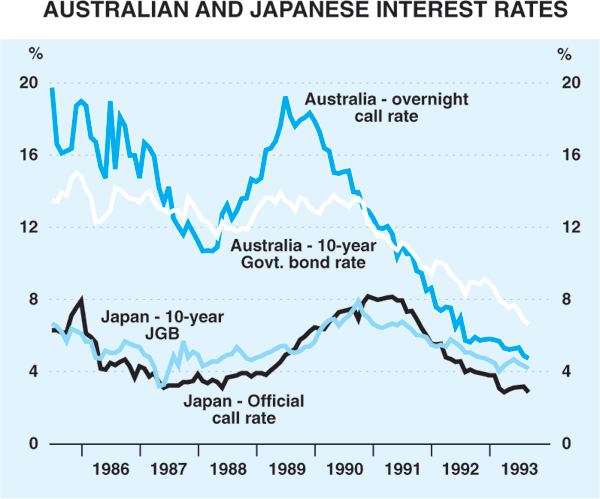
One reason for this is that Australia's inflation rate is back in line with that in Japan and other traditionally low inflation countries. This can be seen in Graph 4; it is a major change compared with the 1970s and 1980s, when Australia was seen as a high inflation country. That perception is now clearly outdated.
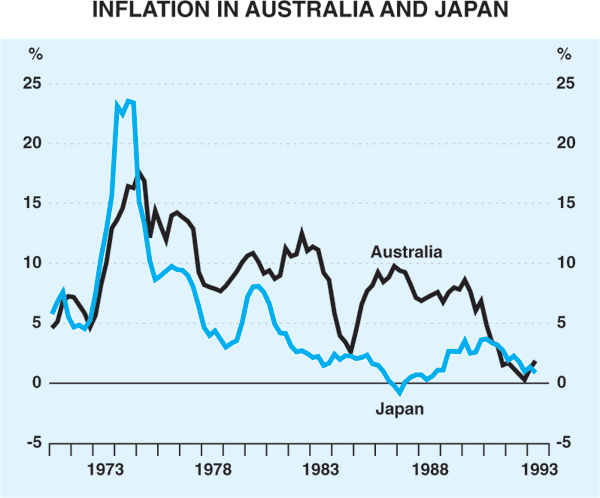
We are confident that inflation will be held in check as the economy picks up. While some ‘one-off’ factors are likely to push the published (or ‘headline’) rate to 3 per cent or a little higher over the next year, we believe the ‘underlying’ rate will be held around 2 to 3 per cent. This belief reflects several factors, not least being the determination of the Reserve Bank and the Government to see that Australia stays in the low inflation league.
They will be assisted in that endeavour by several developments:
- First, expectations of future inflation have fallen as actual inflation has fallen, and these lower expectations are being factored into price and wage setting behaviour.
- Secondly, Australia has become more closely integrated with the international economy, and more exposed to international competitive forces; this is imposing extra discipline on wage and price setters.
- Thirdly, even before the recent recession and the jump in unemployment to around 11 per cent, changes in wages policy were leading to more moderate wage increases and closer linkages to productivity improvements – as the black line in Graph 5 shows, the increases in earnings have been modest for several years (Graph 5 also shows, incidentally, the sustained decline in the number of industrial disputes in Australia; this is another feature of the changing economic landscape).
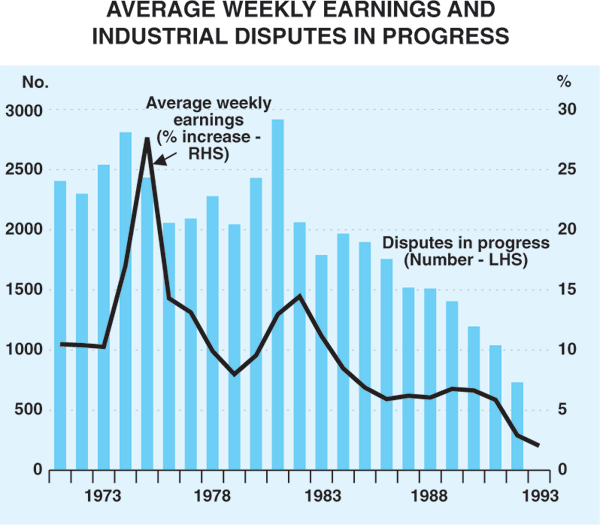
The reductions in official interest rates over the past three and a half years have been mainly in response to domestic developments – specifically, to evidence of declining inflation and sluggish economic recovery. Over the last year or so, the exchange rate has become more significant in the consideration of interest rate changes, mainly because of the potential inflationary consequences of an on-going slump in the $A.
The earlier monetary policy environment is now changing. In particular, the level of economic activity is looking a little stronger, the ‘headline’ (but not the ‘underlying’) rate of inflation is set to rise, and the exchange rate is lower. All this suggests that the long phase of reductions in short-term interest rates is coming to an end.
Exchange Rates
It also brings me to the question of the exchange rate, which is likely to be of more than passing interest to this audience.
In trade-weighted index (TWI) terms, the $A has depreciated by about 20 per cent over the past two years. Against the yen, it has fallen by over 30 per cent; most of this fall occurred over the past year when, as noted earlier, other currencies too have fallen sharply against the yen.
How should this fall be viewed? Stepping back from day-to-day market gyrations, I see it as having a large cyclical component, with the potential for some reversal.
Australia's export base is being steadily broadened but rural and resource commodities still account for two-thirds of total exports of goods and services (compared with over 70 per cent 10 years ago). It is not surprising, therefore, that our currency tends to move broadly in line with commodity prices, which in turn tend to mirror cyclical swings in the world economy.
The close relationship between commodity prices and the trade weighted $A can be seen in Graph 6. In the second half of the 1980s, when world industrial production and commodity prices were generally strong, the $A too was generally strong; so far in the 1990s, when industrial production in OECD countries has declined and commodity prices have fallen, the $A has drifted down.
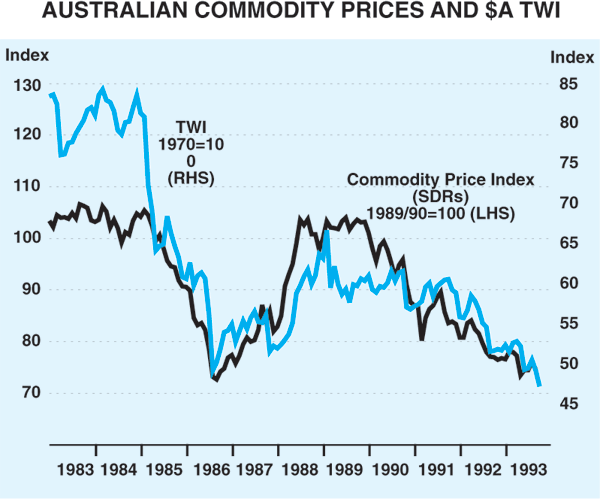
It is well known that the Reserve Bank has intervened heavily in the foreign exchange market on occasions over recent years. In intervening, we have not sought to hold any particular exchange rate: we have recognised that in a weak world economic environment it was logical for a commodity exporting country like Australia to have a lower exchange rate.
What we have sought to do is to counter large and sudden movements which appear to be triggered more by market rumours than fundamental factors and which, unchecked, could threaten inflation and other policy objectives. That continues to be the Bank's approach. To date, we have achieved our objectives with intervention but, if necessary, we would also use interest rates.
How quickly the world economy recovers is obviously very important for Australia, and for the $A. Most commentators remain gloomy about the outlook, although growth in 1994 is generally expected to be somewhat better than in 1993. How much better will depend in part on policy action (or inaction) in larger economies like Japan and Germany to achieve faster growth. Eventually, the world economy will pick up and, as that occurs, the $A also can be expected to recover somewhat. If history is any guide, that recovery could be quite strong.
The Australian economy is growing at about 2½ to 3 per cent, which is better than most OECD countries. We need to grow faster than that but it is difficult to do so in the middle of a world recession. Policy makers in Australia cannot accelerate the world recovery. What they can do is to get their own house in order so that Australia can exploit both the limited market opportunities that presently exist, and the greater opportunities that will come with the eventual turnabout in the world economy.
This process of renovating and strengthening the Australian economy so that it better withstands commodity price and other shocks in the future, has been underway for some time. It is far from completed but good progress is being made. That story, regrettably, is not understood as fully as it deserves to be – either inside or outside the country.
I would like, therefore, to emphasise some key points.
The central theme is a major improvement in Australia's international competitiveness. Several factors stand out here. One is our low inflation and another is the 20 per cent depreciation of the $A (TWI) over the past two years. The fact that Australia's inflation performance has at least matched that of our trading partners means that the large nominal depreciation is being translated into an equally large real depreciation.
The improvement in competitiveness, however, goes much deeper than the recent depreciation of the $A. It is also being built on important structural changes in all sectors of the economy.
I have mentioned already developments in the labour market that are leading to more moderate, productivity-based wage increases. In other markets too, major changes are occurring – in the markets for goods, and for banking, telecommunications, transport and other services, including government services. In some areas, changes need to be pursued further and with greater urgency but our competitiveness is being enhanced. That is why I believe Australia will remain competitive even when the $A moves up on the back of stronger world growth and commodity prices.
The changes are on-going and mutually reinforcing. They reflect deep-seated changes in attitudes and aspirations in all sections of the community. Above all, they reflect a growing realisation that Australia must be internationally competitive if it is to prosper in today's world. They are real changes with profound implications for Australia, although their significance is lost on those whose vision is clouded by short-term preoccupations.
Already there is indisputable evidence that these structural changes are creating a more open and competitive Australian economy. The greater openness is well illustrated by the sharp rise in both exports and imports relative to national output. We can see this in Graph 7; the left hand panel of that graph shows that exports, for example, now represent 20 per cent of output, compared with about 13 per cent a decade ago.
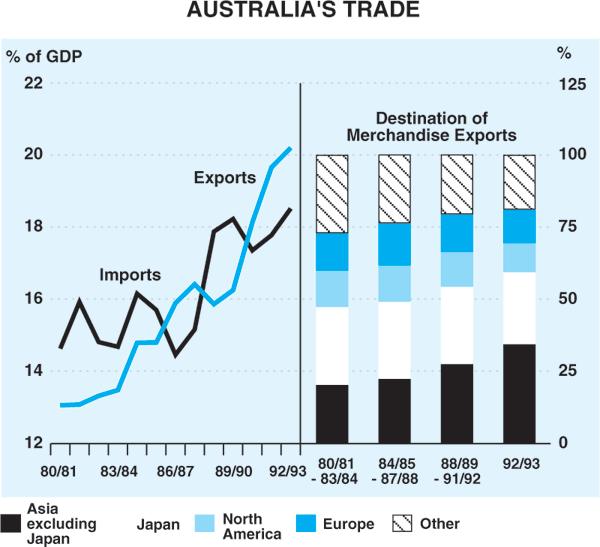
In a fortunate conjuncture of events, the increased openness of the Australian economy has coincided with the rapid growth and industrialisation of the Asian region. This historic change in the pattern of world production and trade has underscored a major relative shift in Australian export markets from Europe and North America to Asia. The right hand panel of Graph 7 shows this shift; over 60 per cent of our merchandise exports now go to Japan and other countries in Asia.
These domestic and international structural changes are altering the composition of Australia's exports. Graph 8 illustrates the point made earlier about the dominance of commodity based exports. At the same time, however, tourism, education and other services have grown rapidly while the most striking feature has been the growth in exports of high value-added manufactured goods; these have grown (in volume terms) at an average annual rate of 14 per cent over the past seven years and now account for more than 15 per cent of total exports.
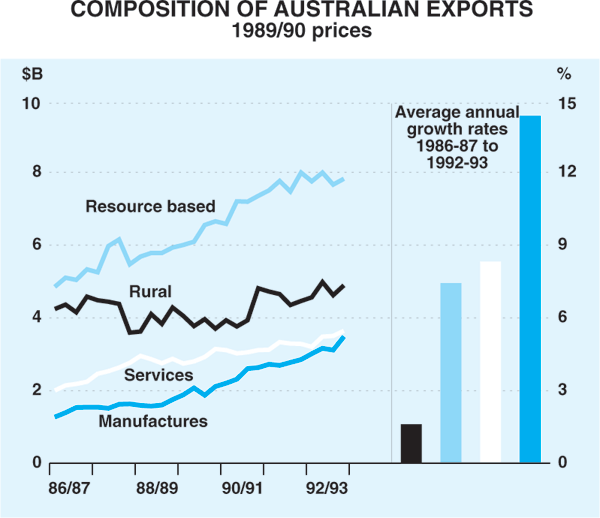
It is worth mentioning, incidentally, that this growth has occurred against the background of a substantial reduction in tariff and other assistance available to the manufacturing sector; the effective rate of assistance has fallen from about 22 per cent in 1984 to less than 15 per cent in 1991. It is continuing to fall.
For the moment, investment growth is the notable absentee in Australia's economic recovery. This is partly because of the weak domestic and international demand, and partly because of the focus by businesses on restructuring their balance sheets. As in other countries, many firms in Australia borrowed extensively to acquire assets in the late 1980s and have been obliged to reduce their balance sheets and unwind their debt. Everywhere this balance sheet restructuring is taking much longer than had been expected, but businesses in Australia appear to be further along the road than in most countries.
With business profits recovering strongly and share prices rising, the funding conditions for a recovery in private investment are improving. Banks in Australia also are over their worst problems and able to respond to stronger demand for business credit when it emerges. In particular, non-performing loans, which impose heavy burdens on banks, have been declining. Graph 9 shows that banks' total non-performing loans declined from a peak of 5.9 per cent of total assets in March 1992 to 3.9 per cent in June 1993. It shows also that the average risk-weighted capital ratio of Australian banks reached 10.9 per cent in June, with all banks well above the 8 per cent minimum requirement.
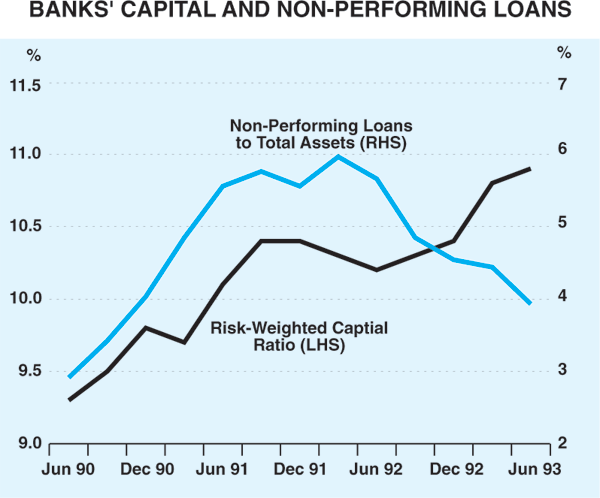
In summary, then, I believe the Australian economy is changing in ways which are adding flexibility and strength, and preparing the ground for solid and sustainable future growth.
As always, there are some constraints on growth. For Australia, these ultimately come down to external constraints in the form of the current account deficit and foreign debt. The current account deficit in 1993/94 is forecast to be about 4 per cent of GDP, compared with an average of 5 per cent in the 1980s, and the 2 to 3 per cent range characteristic of the 1950s and 1960s.
One consequence of running large on-going current account deficits is that we have to borrow heavily overseas to finance them. This generates a growing external debt, which has to be serviced.
If the overseas borrowings are invested wisely, and return at least their servicing costs, this is not a major concern. That has not always been the case in the past but, overall, servicing foreign debt has not been an unmanageable problem for Australia. While the net foreign debt has been rising (to almost 43 per cent of GDP in June 1993), Graph 10 shows that debt service ratios have fallen significantly in recent years (mainly as a consequence of falling domestic and international interest rates).
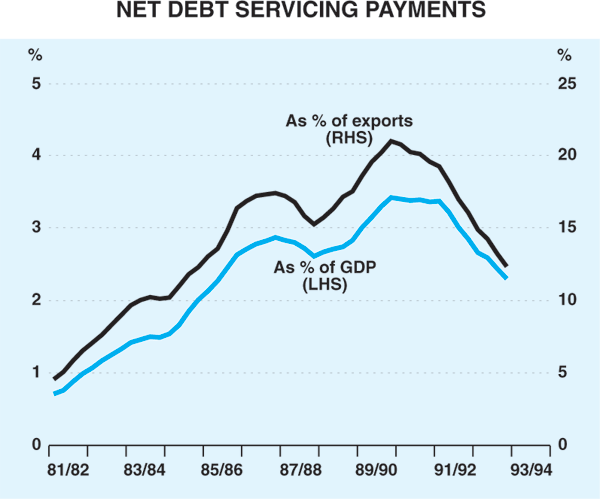
High foreign debt levels do, however, make us vulnerable to major swings in investor sentiment, for whatever reason. If foreign investors were to become disenchanted with Australia to the point of ceasing to lend, the policy options would be both limited and unpleasant. For this reason, the current account deficit needs ultimately to be lowered relative to GDP.
There are two sides to this. One is that we need to sell more to the world – which is why current efforts to make Australian industry more competitive cannot be relaxed.
Secondly, large current account deficits imply a heavy dependence on foreign savings. Over time, we need to reduce the vulnerability associated with large current account deficits by raising our national savings.
That is why implementation of the Australian Government's medium-term budget deficit reduction program is so important. Reductions in the budget deficit – and the generation of budget surpluses – are the surest and quickest means of increasing national savings. The Budget now before the Parliament acknowledges and addresses these linkages; it provides for the budget deficit to be reduced from a cyclical peak of around 4 per cent of GDP in 1993/94 to around 1 per cent by 1996/97 (see Graph 11).
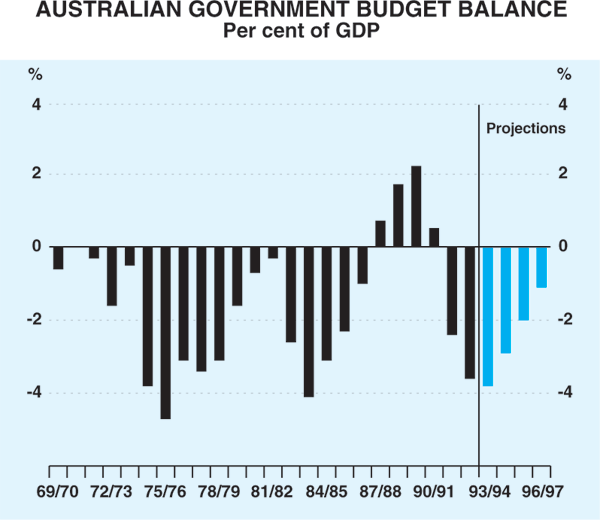
The important linkages between the budget deficit and other policy objectives are not universally understood and politicking over particular budget measures tends to divert attention from them. A lot of criticism recently has been directed at selected tax increases, even though some revenue enhancing measures are inevitable if the deficit is to be lowered over time.
The Budget will be debated further in the Parliament over coming weeks. The Government, which achieved four successive budget surpluses in the late 1980s, knows how important it is for the deficit to be wound back over the medium term. It is committed to its program and is confident it will be implemented.
Conclusion
I trust that Japanese institutions will continue to take a keen interest in Australia, and seek out the investment opportunities which exist. In assessing whether now is the time to be investing more in Australia, I would suggest that you take extra care to distinguish cyclical changes from structural changes. In my view, the structure of the Australian economy is changing in ways which will create favourable investment opportunities for those prepared to see and seize them.
At the end of the day you will, as I said earlier, make your own judgments on these matters; I hope my comments today will help you to make better informed judgments.
